CBB014 Cell Biology Assignment: Mitosis, Meiosis, and Tissues
VerifiedAdded on 2022/10/17
|23
|3642
|7
Homework Assignment
AI Summary
This document presents a detailed solution to a cell biology assignment for an Access to HE Diploma in Nursing, Science & Health and Human Sciences. The assignment covers several key aspects of cell biology, including the structure and function of cell organelles like the mitochondrion, endoplasmic reticulum, and nucleolus, as well as the functions and structural adaptations of the plasma membrane. It explores different transport mechanisms across the plasma membrane, distinguishing between passive and active transport, and explains the processes of osmosis and the sodium-potassium pump. Furthermore, the assignment provides a comparison between mitosis and meiosis, highlighting their differences in terms of cell division, chromosome number, and genetic recombination. The solution also includes an understanding of gas exchange in the lungs and the role of the alveolar membrane, and a discussion on the neuron's plasma membrane. The assignment is designed to assess the student's understanding of cell structure, function, and processes, and their ability to differentiate between various cellular mechanisms.
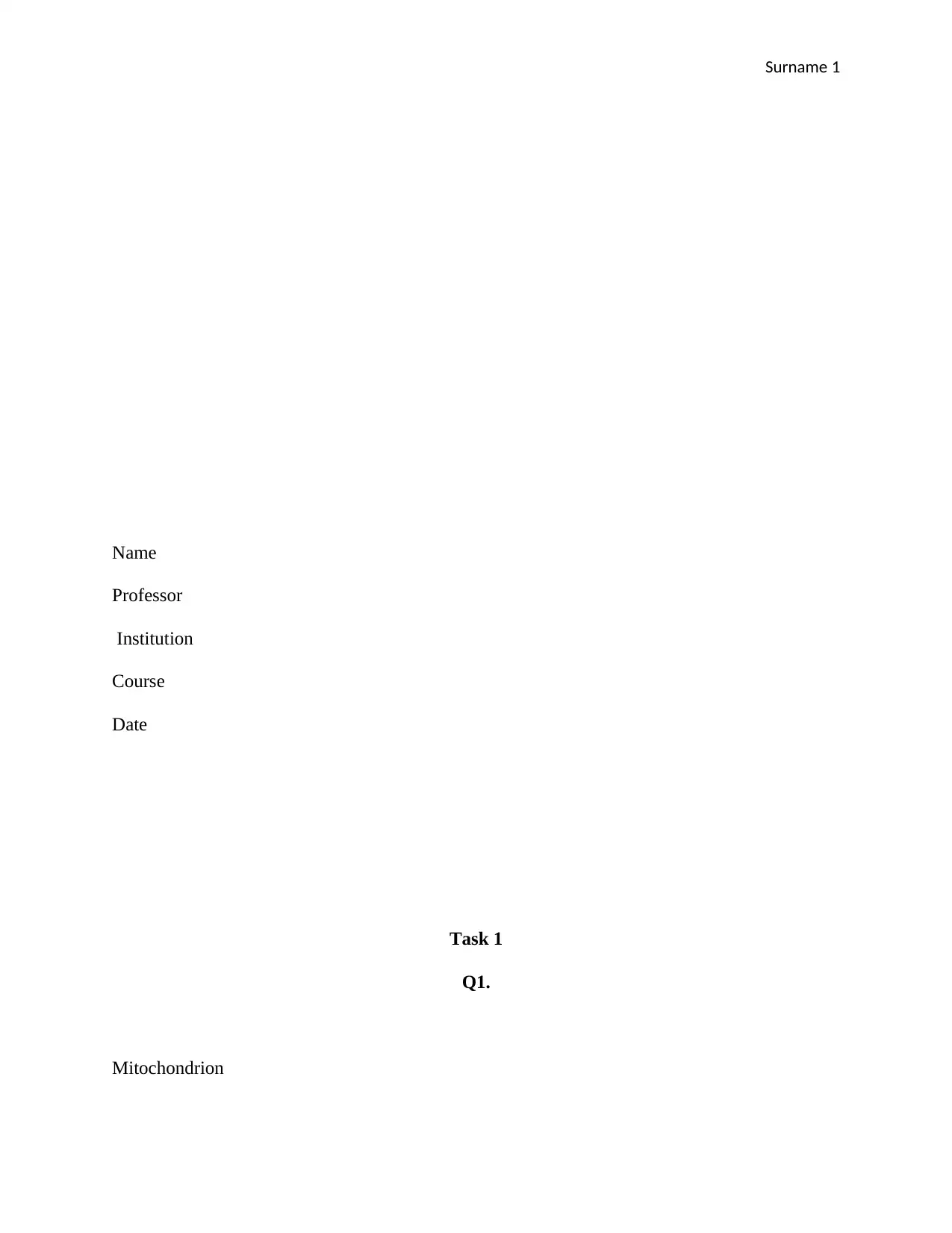
Surname 1
Name
Professor
Institution
Course
Date
Task 1
Q1.
Mitochondrion
Name
Professor
Institution
Course
Date
Task 1
Q1.
Mitochondrion
Paraphrase This Document
Need a fresh take? Get an instant paraphrase of this document with our AI Paraphraser

Surname 2
It is a small oval or sausage- shaped organelle comprising of wrinkles, which releases
energy during aerobic respiration for cellular activities. Where glucose which enters from starch
of the food we eat and the oxygen we breathe from surroundings are required to produce water,
carbon (IV) oxide and energy. Later, the energy is used to for cell actions for instance growth
and reproduction1.
Rough endoplasm
1 Arnold, Torey R., Rachel E. Stephenson, and Ann L. Miller. "Rho GTPases and actomyosin: partners in regulating
epithelial cell-cell junction structure and function." Experimental cell research 358, no. 1 (2017): 20-30.
It is a small oval or sausage- shaped organelle comprising of wrinkles, which releases
energy during aerobic respiration for cellular activities. Where glucose which enters from starch
of the food we eat and the oxygen we breathe from surroundings are required to produce water,
carbon (IV) oxide and energy. Later, the energy is used to for cell actions for instance growth
and reproduction1.
Rough endoplasm
1 Arnold, Torey R., Rachel E. Stephenson, and Ann L. Miller. "Rho GTPases and actomyosin: partners in regulating
epithelial cell-cell junction structure and function." Experimental cell research 358, no. 1 (2017): 20-30.
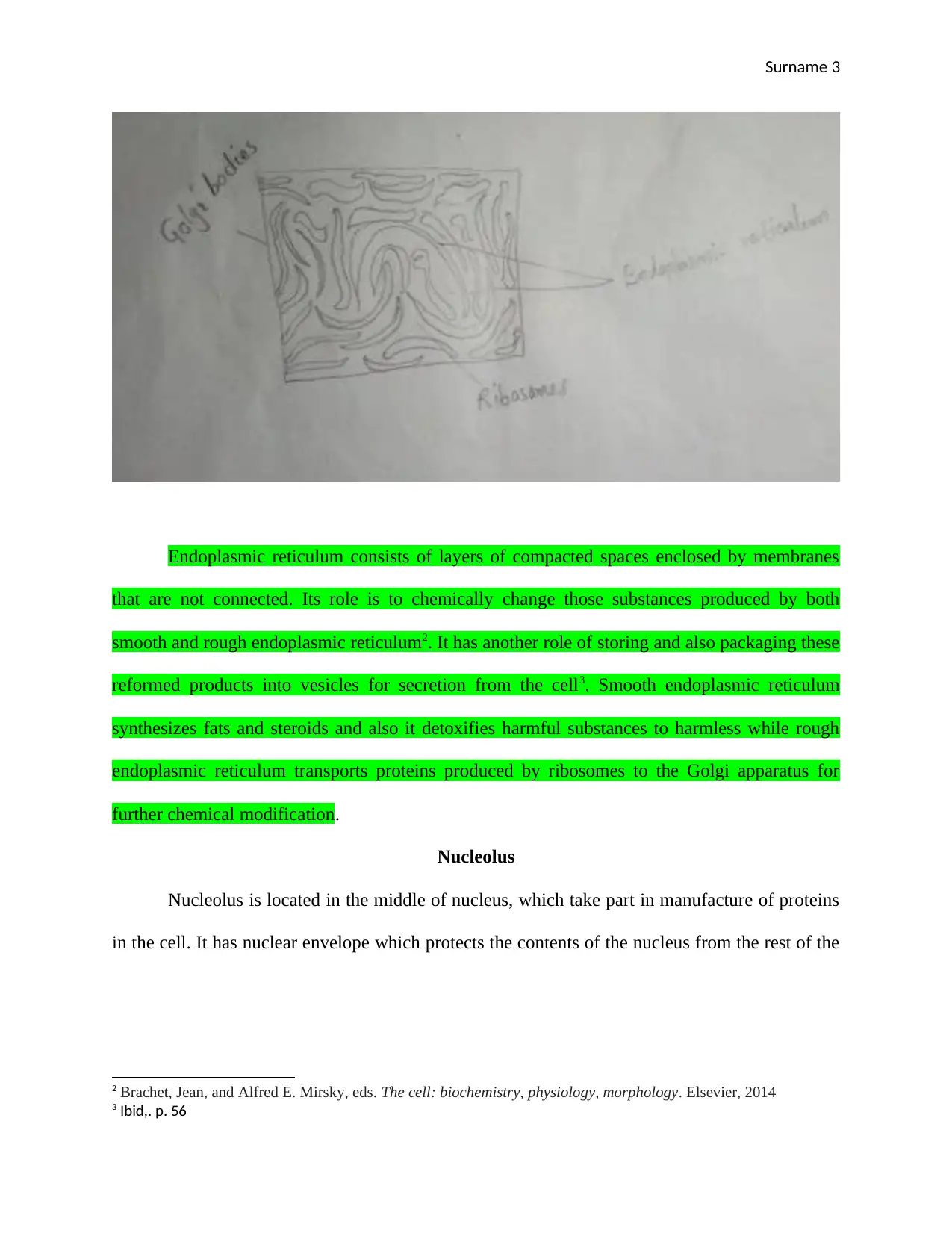
Surname 3
Endoplasmic reticulum consists of layers of compacted spaces enclosed by membranes
that are not connected. Its role is to chemically change those substances produced by both
smooth and rough endoplasmic reticulum2. It has another role of storing and also packaging these
reformed products into vesicles for secretion from the cell3. Smooth endoplasmic reticulum
synthesizes fats and steroids and also it detoxifies harmful substances to harmless while rough
endoplasmic reticulum transports proteins produced by ribosomes to the Golgi apparatus for
further chemical modification.
Nucleolus
Nucleolus is located in the middle of nucleus, which take part in manufacture of proteins
in the cell. It has nuclear envelope which protects the contents of the nucleus from the rest of the
2 Brachet, Jean, and Alfred E. Mirsky, eds. The cell: biochemistry, physiology, morphology. Elsevier, 2014
3 Ibid,. p. 56
Endoplasmic reticulum consists of layers of compacted spaces enclosed by membranes
that are not connected. Its role is to chemically change those substances produced by both
smooth and rough endoplasmic reticulum2. It has another role of storing and also packaging these
reformed products into vesicles for secretion from the cell3. Smooth endoplasmic reticulum
synthesizes fats and steroids and also it detoxifies harmful substances to harmless while rough
endoplasmic reticulum transports proteins produced by ribosomes to the Golgi apparatus for
further chemical modification.
Nucleolus
Nucleolus is located in the middle of nucleus, which take part in manufacture of proteins
in the cell. It has nuclear envelope which protects the contents of the nucleus from the rest of the
2 Brachet, Jean, and Alfred E. Mirsky, eds. The cell: biochemistry, physiology, morphology. Elsevier, 2014
3 Ibid,. p. 56
⊘ This is a preview!⊘
Do you want full access?
Subscribe today to unlock all pages.

Trusted by 1+ million students worldwide
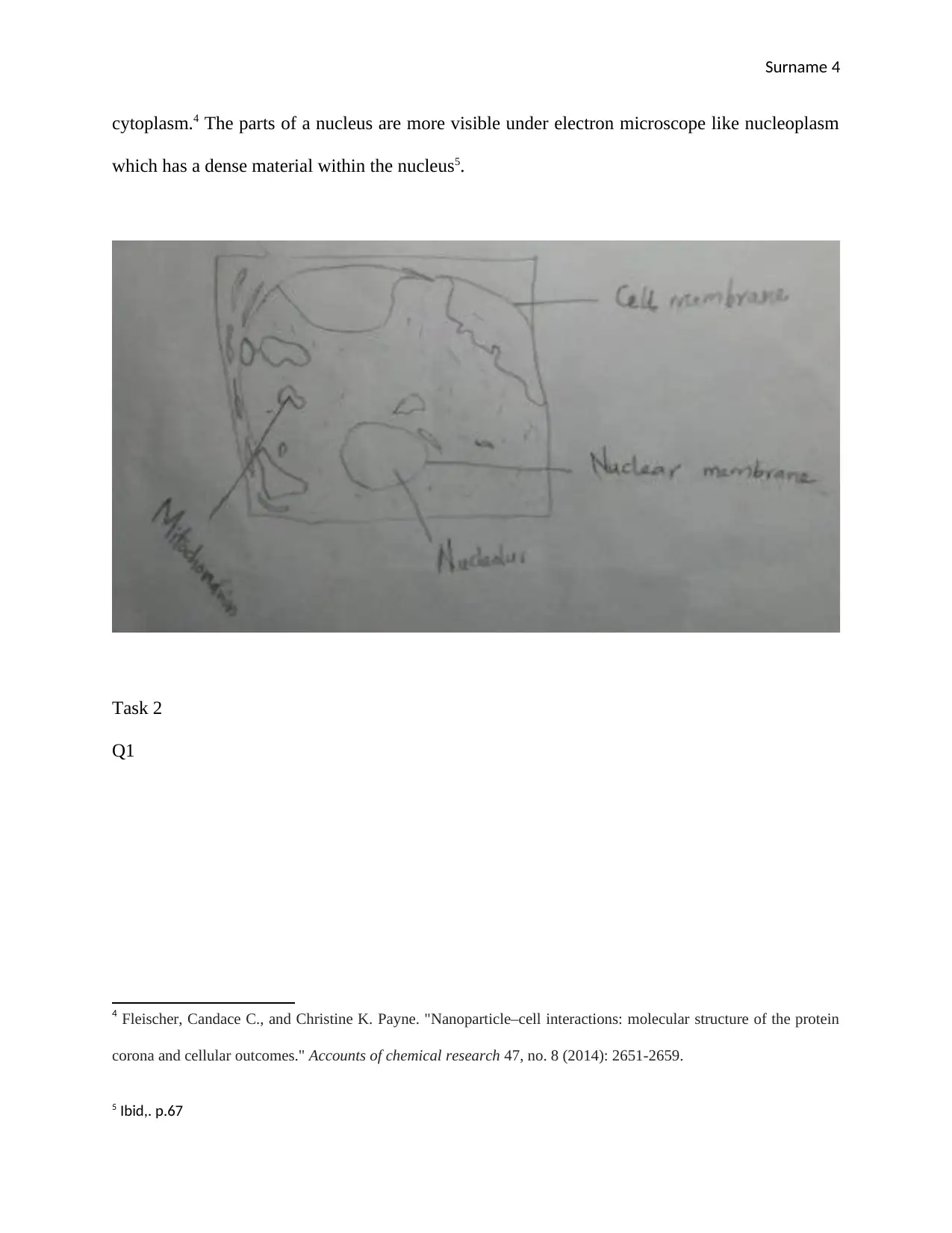
Surname 4
cytoplasm.4 The parts of a nucleus are more visible under electron microscope like nucleoplasm
which has a dense material within the nucleus5.
Task 2
Q1
4 Fleischer, Candace C., and Christine K. Payne. "Nanoparticle–cell interactions: molecular structure of the protein
corona and cellular outcomes." Accounts of chemical research 47, no. 8 (2014): 2651-2659.
5 Ibid,. p.67
cytoplasm.4 The parts of a nucleus are more visible under electron microscope like nucleoplasm
which has a dense material within the nucleus5.
Task 2
Q1
4 Fleischer, Candace C., and Christine K. Payne. "Nanoparticle–cell interactions: molecular structure of the protein
corona and cellular outcomes." Accounts of chemical research 47, no. 8 (2014): 2651-2659.
5 Ibid,. p.67
Paraphrase This Document
Need a fresh take? Get an instant paraphrase of this document with our AI Paraphraser

Surname 5
Functions of plasma membrane
It regulates what enters the cell and what comes out of the cell.
It regulates molecular circulation in the cell.
It has protein deposits which act as pumps, receptors, or any operational components.6
Plasma membrane splits the contents of the cell from the outside atmosphere.
Has lipid bi layer which is semi permeable and permits molecules to diffuse across the
membrane.
6 Florencio-Silva, Rinaldo, Gisela Rodrigues da Silva Sasso, Estela Sasso-Cerri, Manuel Jesus Simões, and Paulo
Sérgio Cerri. "Biology of bone tissue: structure, function, and factors that influence bone cells." BioMed research
international 2015 (2015).
Functions of plasma membrane
It regulates what enters the cell and what comes out of the cell.
It regulates molecular circulation in the cell.
It has protein deposits which act as pumps, receptors, or any operational components.6
Plasma membrane splits the contents of the cell from the outside atmosphere.
Has lipid bi layer which is semi permeable and permits molecules to diffuse across the
membrane.
6 Florencio-Silva, Rinaldo, Gisela Rodrigues da Silva Sasso, Estela Sasso-Cerri, Manuel Jesus Simões, and Paulo
Sérgio Cerri. "Biology of bone tissue: structure, function, and factors that influence bone cells." BioMed research
international 2015 (2015).
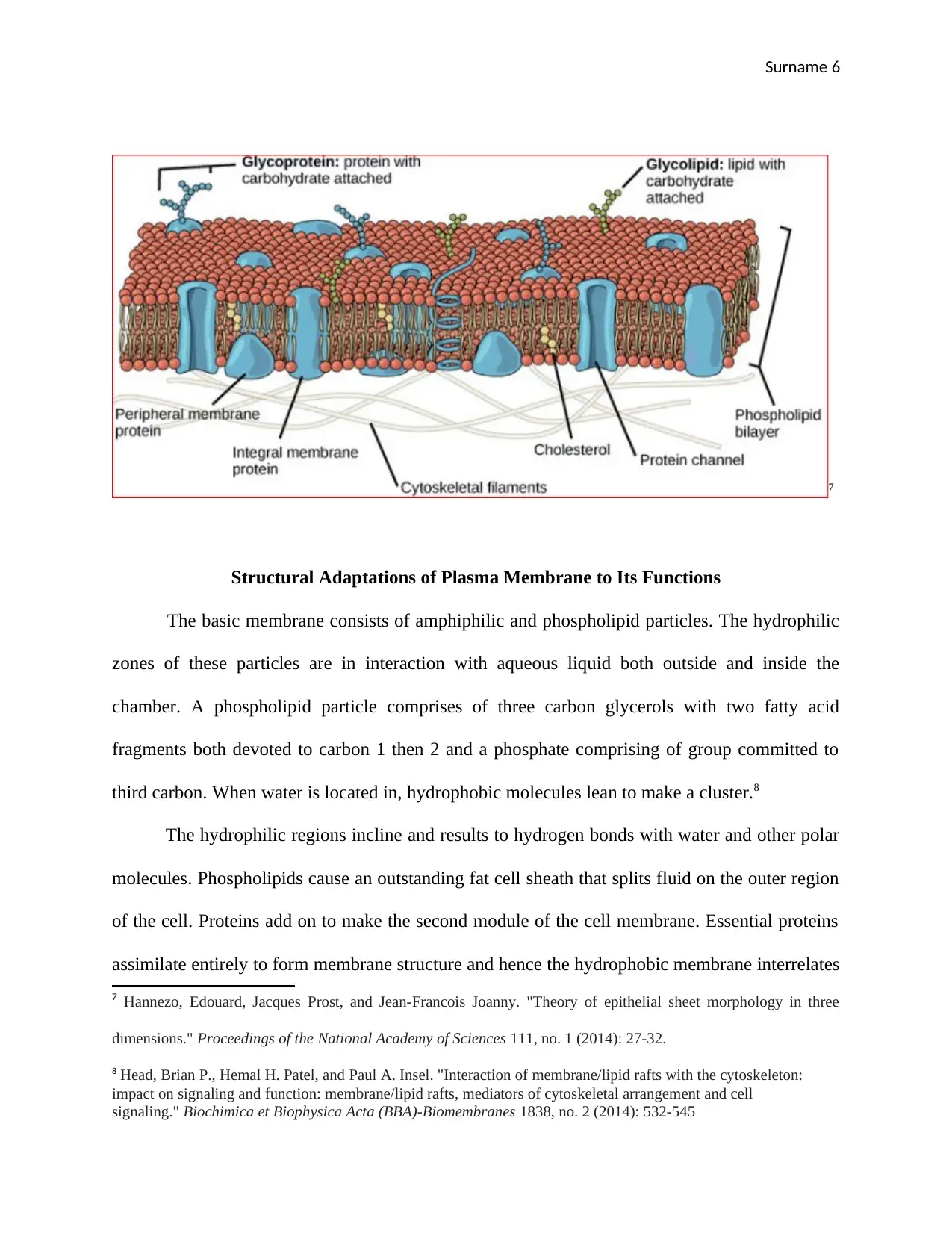
Surname 6
7
Structural Adaptations of Plasma Membrane to Its Functions
The basic membrane consists of amphiphilic and phospholipid particles. The hydrophilic
zones of these particles are in interaction with aqueous liquid both outside and inside the
chamber. A phospholipid particle comprises of three carbon glycerols with two fatty acid
fragments both devoted to carbon 1 then 2 and a phosphate comprising of group committed to
third carbon. When water is located in, hydrophobic molecules lean to make a cluster.8
The hydrophilic regions incline and results to hydrogen bonds with water and other polar
molecules. Phospholipids cause an outstanding fat cell sheath that splits fluid on the outer region
of the cell. Proteins add on to make the second module of the cell membrane. Essential proteins
assimilate entirely to form membrane structure and hence the hydrophobic membrane interrelates
7 Hannezo, Edouard, Jacques Prost, and Jean-Francois Joanny. "Theory of epithelial sheet morphology in three
dimensions." Proceedings of the National Academy of Sciences 111, no. 1 (2014): 27-32.
8 Head, Brian P., Hemal H. Patel, and Paul A. Insel. "Interaction of membrane/lipid rafts with the cytoskeleton:
impact on signaling and function: membrane/lipid rafts, mediators of cytoskeletal arrangement and cell
signaling." Biochimica et Biophysica Acta (BBA)-Biomembranes 1838, no. 2 (2014): 532-545
7
Structural Adaptations of Plasma Membrane to Its Functions
The basic membrane consists of amphiphilic and phospholipid particles. The hydrophilic
zones of these particles are in interaction with aqueous liquid both outside and inside the
chamber. A phospholipid particle comprises of three carbon glycerols with two fatty acid
fragments both devoted to carbon 1 then 2 and a phosphate comprising of group committed to
third carbon. When water is located in, hydrophobic molecules lean to make a cluster.8
The hydrophilic regions incline and results to hydrogen bonds with water and other polar
molecules. Phospholipids cause an outstanding fat cell sheath that splits fluid on the outer region
of the cell. Proteins add on to make the second module of the cell membrane. Essential proteins
assimilate entirely to form membrane structure and hence the hydrophobic membrane interrelates
7 Hannezo, Edouard, Jacques Prost, and Jean-Francois Joanny. "Theory of epithelial sheet morphology in three
dimensions." Proceedings of the National Academy of Sciences 111, no. 1 (2014): 27-32.
8 Head, Brian P., Hemal H. Patel, and Paul A. Insel. "Interaction of membrane/lipid rafts with the cytoskeleton:
impact on signaling and function: membrane/lipid rafts, mediators of cytoskeletal arrangement and cell
signaling." Biochimica et Biophysica Acta (BBA)-Biomembranes 1838, no. 2 (2014): 532-545
⊘ This is a preview!⊘
Do you want full access?
Subscribe today to unlock all pages.

Trusted by 1+ million students worldwide
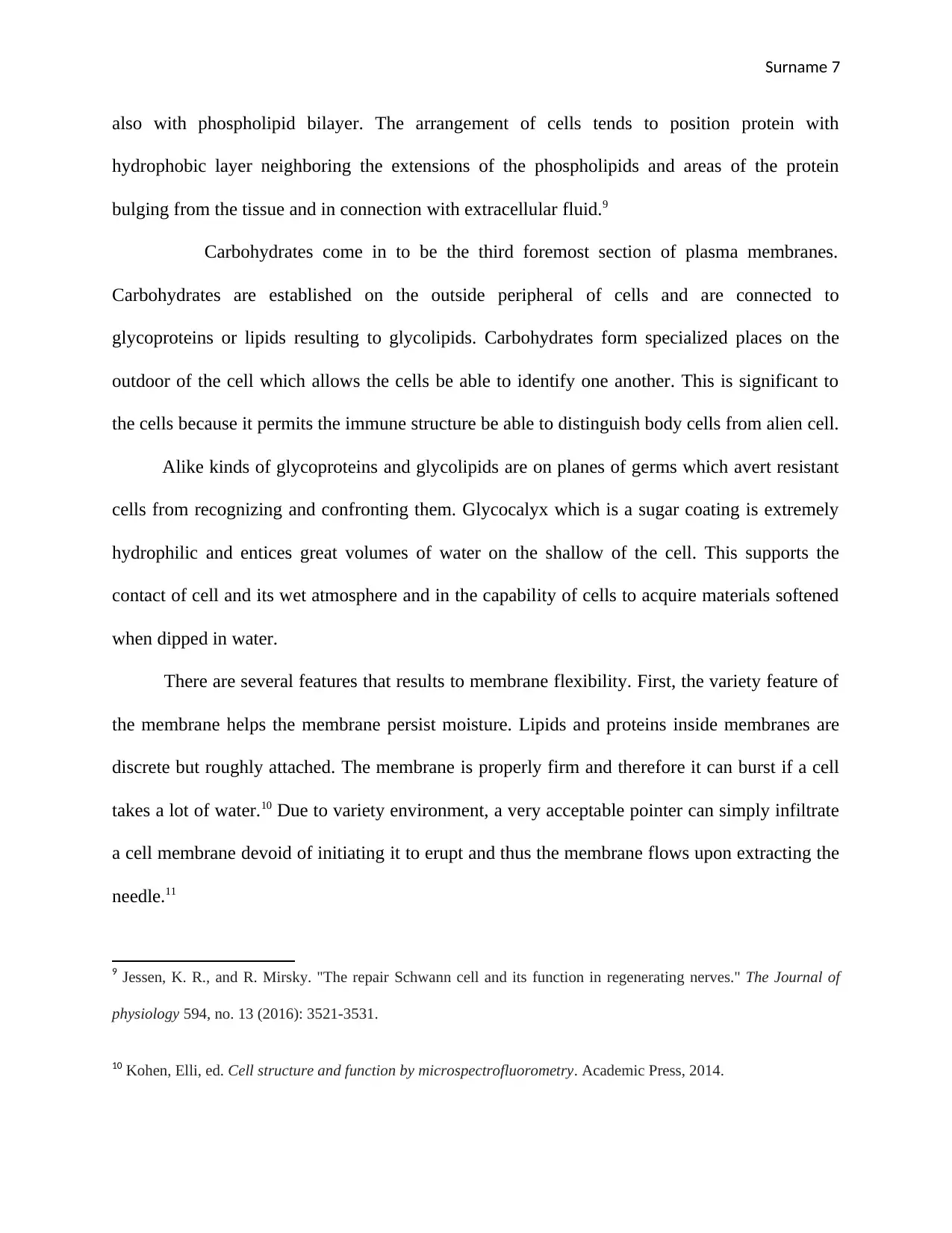
Surname 7
also with phospholipid bilayer. The arrangement of cells tends to position protein with
hydrophobic layer neighboring the extensions of the phospholipids and areas of the protein
bulging from the tissue and in connection with extracellular fluid.9
Carbohydrates come in to be the third foremost section of plasma membranes.
Carbohydrates are established on the outside peripheral of cells and are connected to
glycoproteins or lipids resulting to glycolipids. Carbohydrates form specialized places on the
outdoor of the cell which allows the cells be able to identify one another. This is significant to
the cells because it permits the immune structure be able to distinguish body cells from alien cell.
Alike kinds of glycoproteins and glycolipids are on planes of germs which avert resistant
cells from recognizing and confronting them. Glycocalyx which is a sugar coating is extremely
hydrophilic and entices great volumes of water on the shallow of the cell. This supports the
contact of cell and its wet atmosphere and in the capability of cells to acquire materials softened
when dipped in water.
There are several features that results to membrane flexibility. First, the variety feature of
the membrane helps the membrane persist moisture. Lipids and proteins inside membranes are
discrete but roughly attached. The membrane is properly firm and therefore it can burst if a cell
takes a lot of water.10 Due to variety environment, a very acceptable pointer can simply infiltrate
a cell membrane devoid of initiating it to erupt and thus the membrane flows upon extracting the
needle.11
9 Jessen, K. R., and R. Mirsky. "The repair Schwann cell and its function in regenerating nerves." The Journal of
physiology 594, no. 13 (2016): 3521-3531.
10 Kohen, Elli, ed. Cell structure and function by microspectrofluorometry. Academic Press, 2014.
also with phospholipid bilayer. The arrangement of cells tends to position protein with
hydrophobic layer neighboring the extensions of the phospholipids and areas of the protein
bulging from the tissue and in connection with extracellular fluid.9
Carbohydrates come in to be the third foremost section of plasma membranes.
Carbohydrates are established on the outside peripheral of cells and are connected to
glycoproteins or lipids resulting to glycolipids. Carbohydrates form specialized places on the
outdoor of the cell which allows the cells be able to identify one another. This is significant to
the cells because it permits the immune structure be able to distinguish body cells from alien cell.
Alike kinds of glycoproteins and glycolipids are on planes of germs which avert resistant
cells from recognizing and confronting them. Glycocalyx which is a sugar coating is extremely
hydrophilic and entices great volumes of water on the shallow of the cell. This supports the
contact of cell and its wet atmosphere and in the capability of cells to acquire materials softened
when dipped in water.
There are several features that results to membrane flexibility. First, the variety feature of
the membrane helps the membrane persist moisture. Lipids and proteins inside membranes are
discrete but roughly attached. The membrane is properly firm and therefore it can burst if a cell
takes a lot of water.10 Due to variety environment, a very acceptable pointer can simply infiltrate
a cell membrane devoid of initiating it to erupt and thus the membrane flows upon extracting the
needle.11
9 Jessen, K. R., and R. Mirsky. "The repair Schwann cell and its function in regenerating nerves." The Journal of
physiology 594, no. 13 (2016): 3521-3531.
10 Kohen, Elli, ed. Cell structure and function by microspectrofluorometry. Academic Press, 2014.
Paraphrase This Document
Need a fresh take? Get an instant paraphrase of this document with our AI Paraphraser
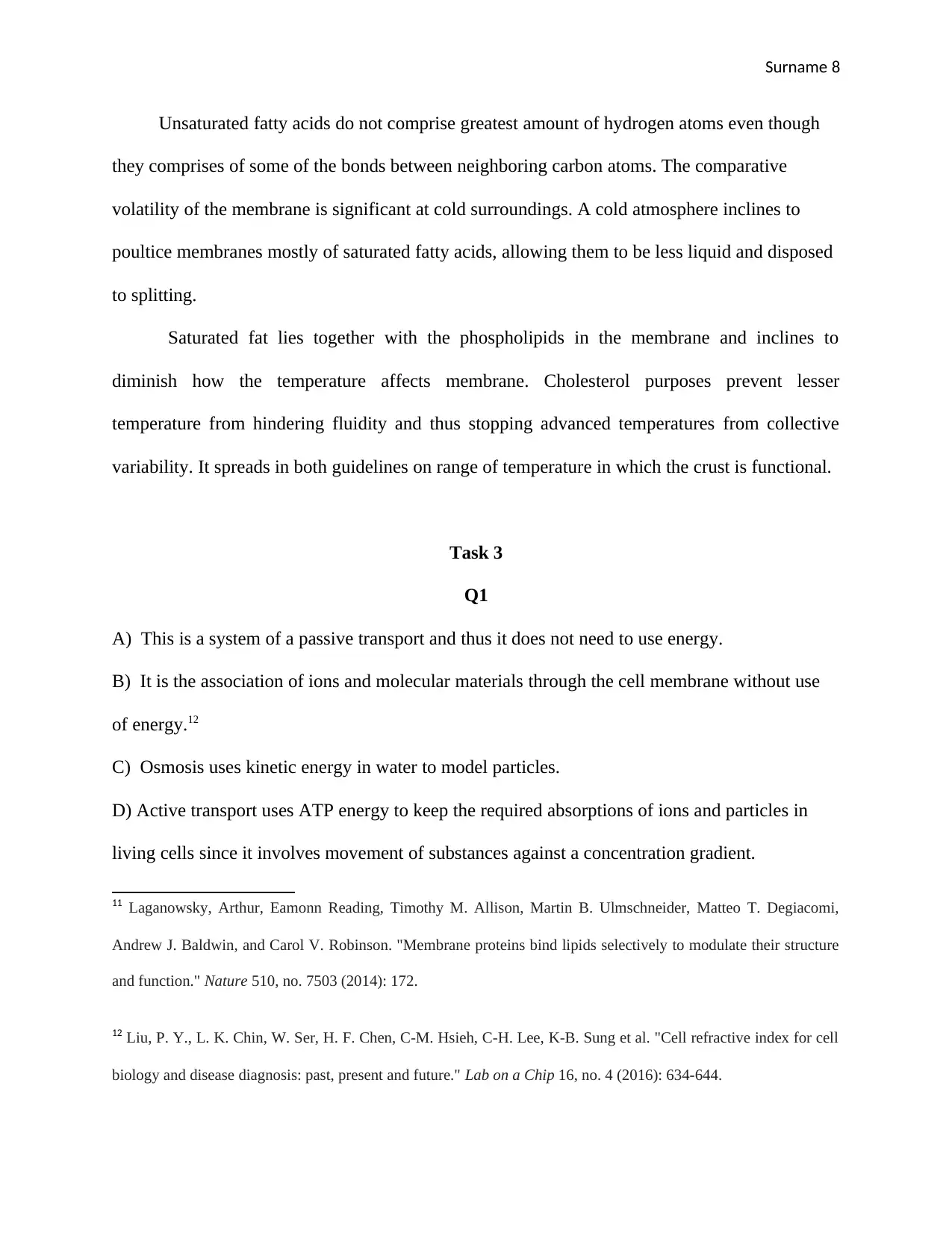
Surname 8
Unsaturated fatty acids do not comprise greatest amount of hydrogen atoms even though
they comprises of some of the bonds between neighboring carbon atoms. The comparative
volatility of the membrane is significant at cold surroundings. A cold atmosphere inclines to
poultice membranes mostly of saturated fatty acids, allowing them to be less liquid and disposed
to splitting.
Saturated fat lies together with the phospholipids in the membrane and inclines to
diminish how the temperature affects membrane. Cholesterol purposes prevent lesser
temperature from hindering fluidity and thus stopping advanced temperatures from collective
variability. It spreads in both guidelines on range of temperature in which the crust is functional.
Task 3
Q1
A) This is a system of a passive transport and thus it does not need to use energy.
B) It is the association of ions and molecular materials through the cell membrane without use
of energy.12
C) Osmosis uses kinetic energy in water to model particles.
D) Active transport uses ATP energy to keep the required absorptions of ions and particles in
living cells since it involves movement of substances against a concentration gradient.
11 Laganowsky, Arthur, Eamonn Reading, Timothy M. Allison, Martin B. Ulmschneider, Matteo T. Degiacomi,
Andrew J. Baldwin, and Carol V. Robinson. "Membrane proteins bind lipids selectively to modulate their structure
and function." Nature 510, no. 7503 (2014): 172.
12 Liu, P. Y., L. K. Chin, W. Ser, H. F. Chen, C-M. Hsieh, C-H. Lee, K-B. Sung et al. "Cell refractive index for cell
biology and disease diagnosis: past, present and future." Lab on a Chip 16, no. 4 (2016): 634-644.
Unsaturated fatty acids do not comprise greatest amount of hydrogen atoms even though
they comprises of some of the bonds between neighboring carbon atoms. The comparative
volatility of the membrane is significant at cold surroundings. A cold atmosphere inclines to
poultice membranes mostly of saturated fatty acids, allowing them to be less liquid and disposed
to splitting.
Saturated fat lies together with the phospholipids in the membrane and inclines to
diminish how the temperature affects membrane. Cholesterol purposes prevent lesser
temperature from hindering fluidity and thus stopping advanced temperatures from collective
variability. It spreads in both guidelines on range of temperature in which the crust is functional.
Task 3
Q1
A) This is a system of a passive transport and thus it does not need to use energy.
B) It is the association of ions and molecular materials through the cell membrane without use
of energy.12
C) Osmosis uses kinetic energy in water to model particles.
D) Active transport uses ATP energy to keep the required absorptions of ions and particles in
living cells since it involves movement of substances against a concentration gradient.
11 Laganowsky, Arthur, Eamonn Reading, Timothy M. Allison, Martin B. Ulmschneider, Matteo T. Degiacomi,
Andrew J. Baldwin, and Carol V. Robinson. "Membrane proteins bind lipids selectively to modulate their structure
and function." Nature 510, no. 7503 (2014): 172.
12 Liu, P. Y., L. K. Chin, W. Ser, H. F. Chen, C-M. Hsieh, C-H. Lee, K-B. Sung et al. "Cell refractive index for cell
biology and disease diagnosis: past, present and future." Lab on a Chip 16, no. 4 (2016): 634-644.
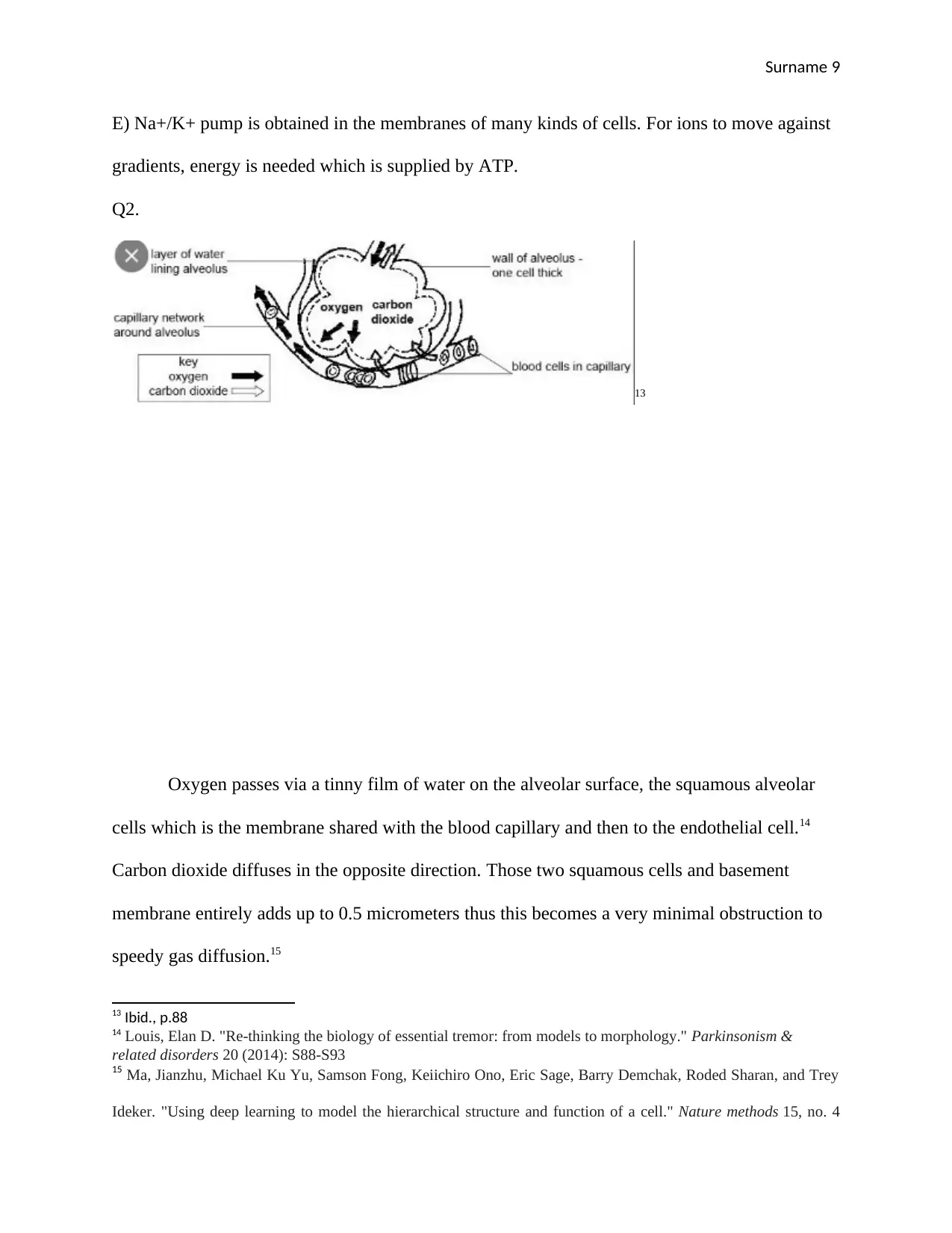
Surname 9
E) Na+/K+ pump is obtained in the membranes of many kinds of cells. For ions to move against
gradients, energy is needed which is supplied by ATP.
Q2.
13
Oxygen passes via a tinny film of water on the alveolar surface, the squamous alveolar
cells which is the membrane shared with the blood capillary and then to the endothelial cell.14
Carbon dioxide diffuses in the opposite direction. Those two squamous cells and basement
membrane entirely adds up to 0.5 micrometers thus this becomes a very minimal obstruction to
speedy gas diffusion.15
13 Ibid., p.88
14 Louis, Elan D. "Re-thinking the biology of essential tremor: from models to morphology." Parkinsonism &
related disorders 20 (2014): S88-S93
15 Ma, Jianzhu, Michael Ku Yu, Samson Fong, Keiichiro Ono, Eric Sage, Barry Demchak, Roded Sharan, and Trey
Ideker. "Using deep learning to model the hierarchical structure and function of a cell." Nature methods 15, no. 4
E) Na+/K+ pump is obtained in the membranes of many kinds of cells. For ions to move against
gradients, energy is needed which is supplied by ATP.
Q2.
13
Oxygen passes via a tinny film of water on the alveolar surface, the squamous alveolar
cells which is the membrane shared with the blood capillary and then to the endothelial cell.14
Carbon dioxide diffuses in the opposite direction. Those two squamous cells and basement
membrane entirely adds up to 0.5 micrometers thus this becomes a very minimal obstruction to
speedy gas diffusion.15
13 Ibid., p.88
14 Louis, Elan D. "Re-thinking the biology of essential tremor: from models to morphology." Parkinsonism &
related disorders 20 (2014): S88-S93
15 Ma, Jianzhu, Michael Ku Yu, Samson Fong, Keiichiro Ono, Eric Sage, Barry Demchak, Roded Sharan, and Trey
Ideker. "Using deep learning to model the hierarchical structure and function of a cell." Nature methods 15, no. 4
⊘ This is a preview!⊘
Do you want full access?
Subscribe today to unlock all pages.

Trusted by 1+ million students worldwide
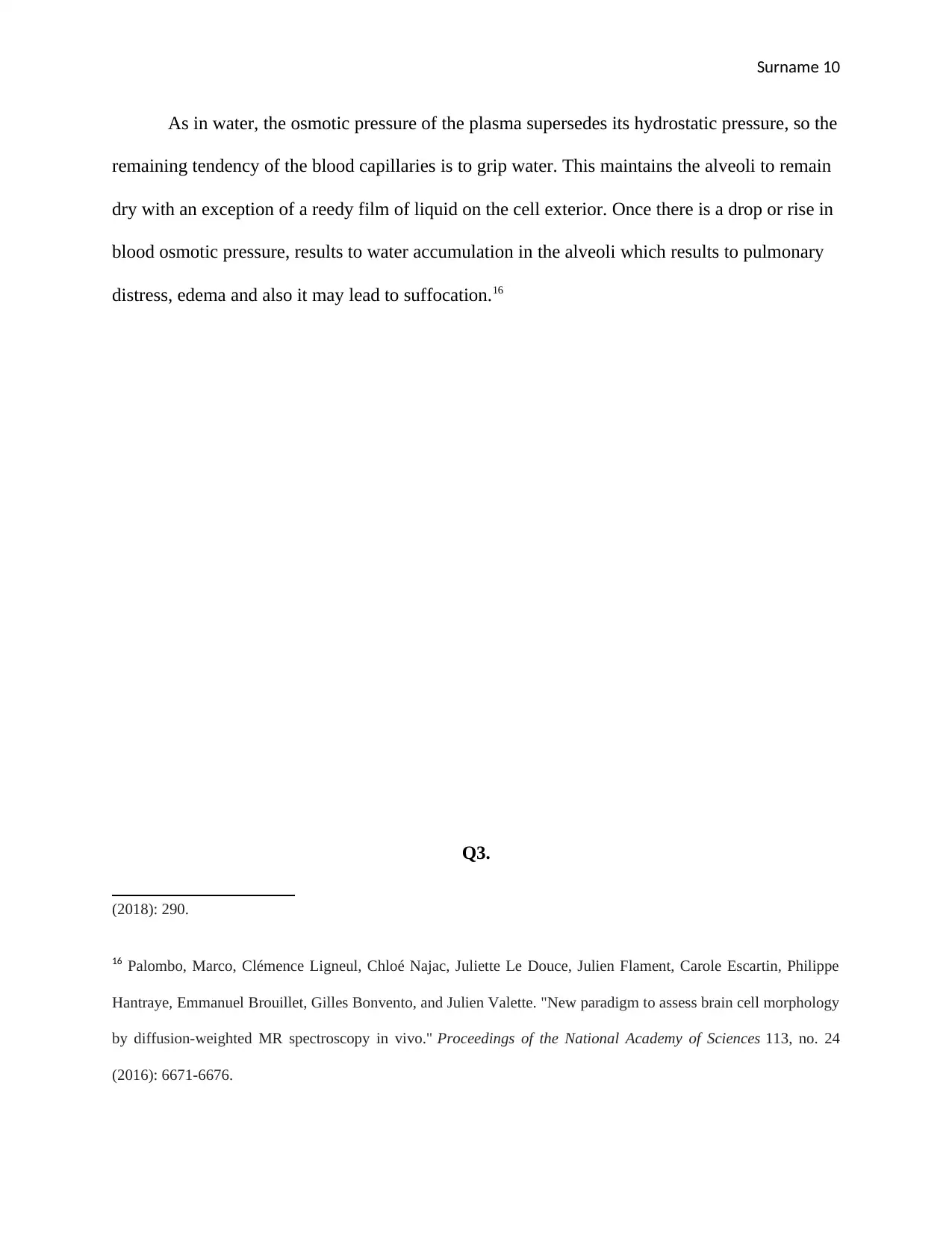
Surname 10
As in water, the osmotic pressure of the plasma supersedes its hydrostatic pressure, so the
remaining tendency of the blood capillaries is to grip water. This maintains the alveoli to remain
dry with an exception of a reedy film of liquid on the cell exterior. Once there is a drop or rise in
blood osmotic pressure, results to water accumulation in the alveoli which results to pulmonary
distress, edema and also it may lead to suffocation.16
Q3.
(2018): 290.
16 Palombo, Marco, Clémence Ligneul, Chloé Najac, Juliette Le Douce, Julien Flament, Carole Escartin, Philippe
Hantraye, Emmanuel Brouillet, Gilles Bonvento, and Julien Valette. "New paradigm to assess brain cell morphology
by diffusion-weighted MR spectroscopy in vivo." Proceedings of the National Academy of Sciences 113, no. 24
(2016): 6671-6676.
As in water, the osmotic pressure of the plasma supersedes its hydrostatic pressure, so the
remaining tendency of the blood capillaries is to grip water. This maintains the alveoli to remain
dry with an exception of a reedy film of liquid on the cell exterior. Once there is a drop or rise in
blood osmotic pressure, results to water accumulation in the alveoli which results to pulmonary
distress, edema and also it may lead to suffocation.16
Q3.
(2018): 290.
16 Palombo, Marco, Clémence Ligneul, Chloé Najac, Juliette Le Douce, Julien Flament, Carole Escartin, Philippe
Hantraye, Emmanuel Brouillet, Gilles Bonvento, and Julien Valette. "New paradigm to assess brain cell morphology
by diffusion-weighted MR spectroscopy in vivo." Proceedings of the National Academy of Sciences 113, no. 24
(2016): 6671-6676.
Paraphrase This Document
Need a fresh take? Get an instant paraphrase of this document with our AI Paraphraser
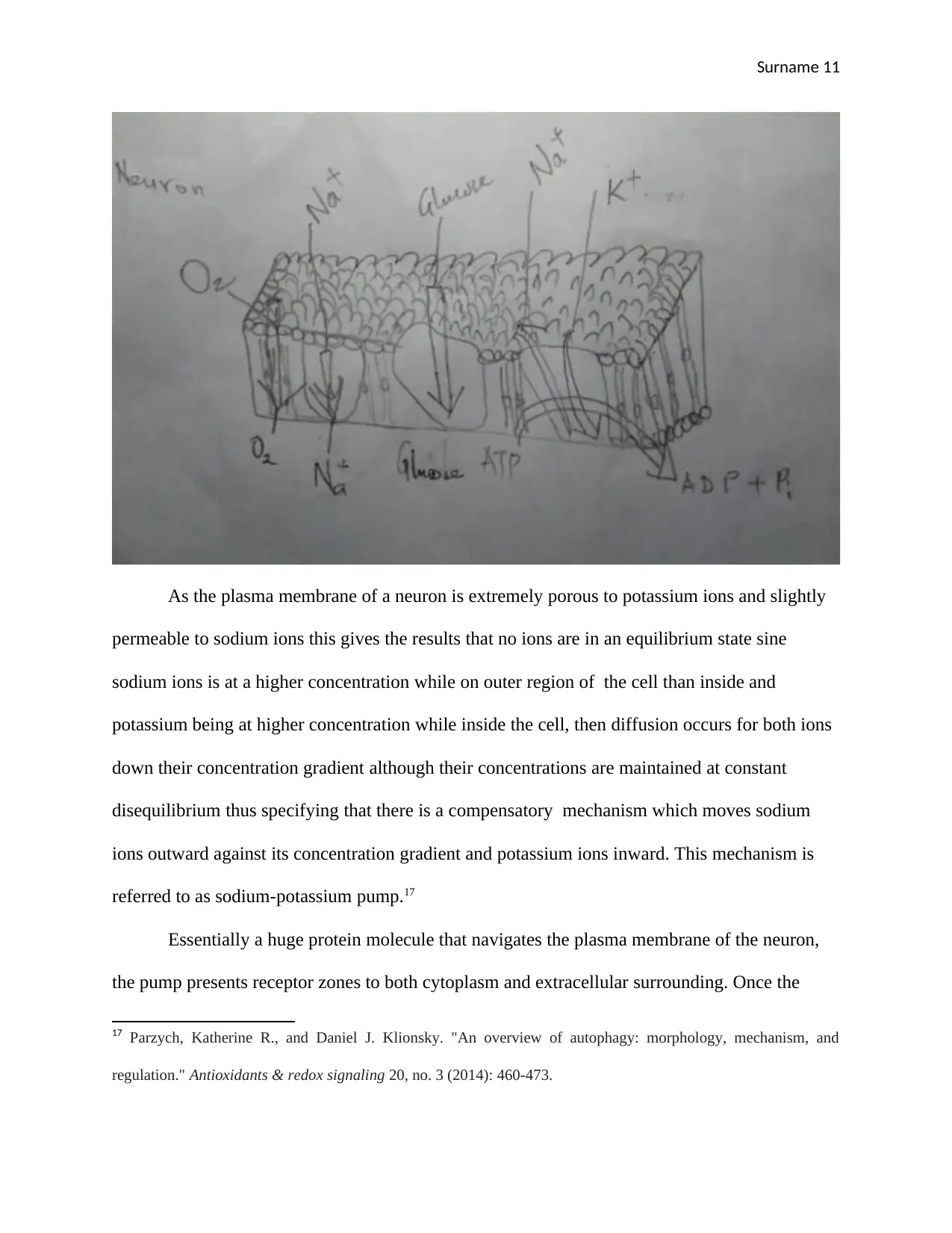
Surname 11
As the plasma membrane of a neuron is extremely porous to potassium ions and slightly
permeable to sodium ions this gives the results that no ions are in an equilibrium state sine
sodium ions is at a higher concentration while on outer region of the cell than inside and
potassium being at higher concentration while inside the cell, then diffusion occurs for both ions
down their concentration gradient although their concentrations are maintained at constant
disequilibrium thus specifying that there is a compensatory mechanism which moves sodium
ions outward against its concentration gradient and potassium ions inward. This mechanism is
referred to as sodium-potassium pump.17
Essentially a huge protein molecule that navigates the plasma membrane of the neuron,
the pump presents receptor zones to both cytoplasm and extracellular surrounding. Once the
17 Parzych, Katherine R., and Daniel J. Klionsky. "An overview of autophagy: morphology, mechanism, and
regulation." Antioxidants & redox signaling 20, no. 3 (2014): 460-473.
As the plasma membrane of a neuron is extremely porous to potassium ions and slightly
permeable to sodium ions this gives the results that no ions are in an equilibrium state sine
sodium ions is at a higher concentration while on outer region of the cell than inside and
potassium being at higher concentration while inside the cell, then diffusion occurs for both ions
down their concentration gradient although their concentrations are maintained at constant
disequilibrium thus specifying that there is a compensatory mechanism which moves sodium
ions outward against its concentration gradient and potassium ions inward. This mechanism is
referred to as sodium-potassium pump.17
Essentially a huge protein molecule that navigates the plasma membrane of the neuron,
the pump presents receptor zones to both cytoplasm and extracellular surrounding. Once the
17 Parzych, Katherine R., and Daniel J. Klionsky. "An overview of autophagy: morphology, mechanism, and
regulation." Antioxidants & redox signaling 20, no. 3 (2014): 460-473.
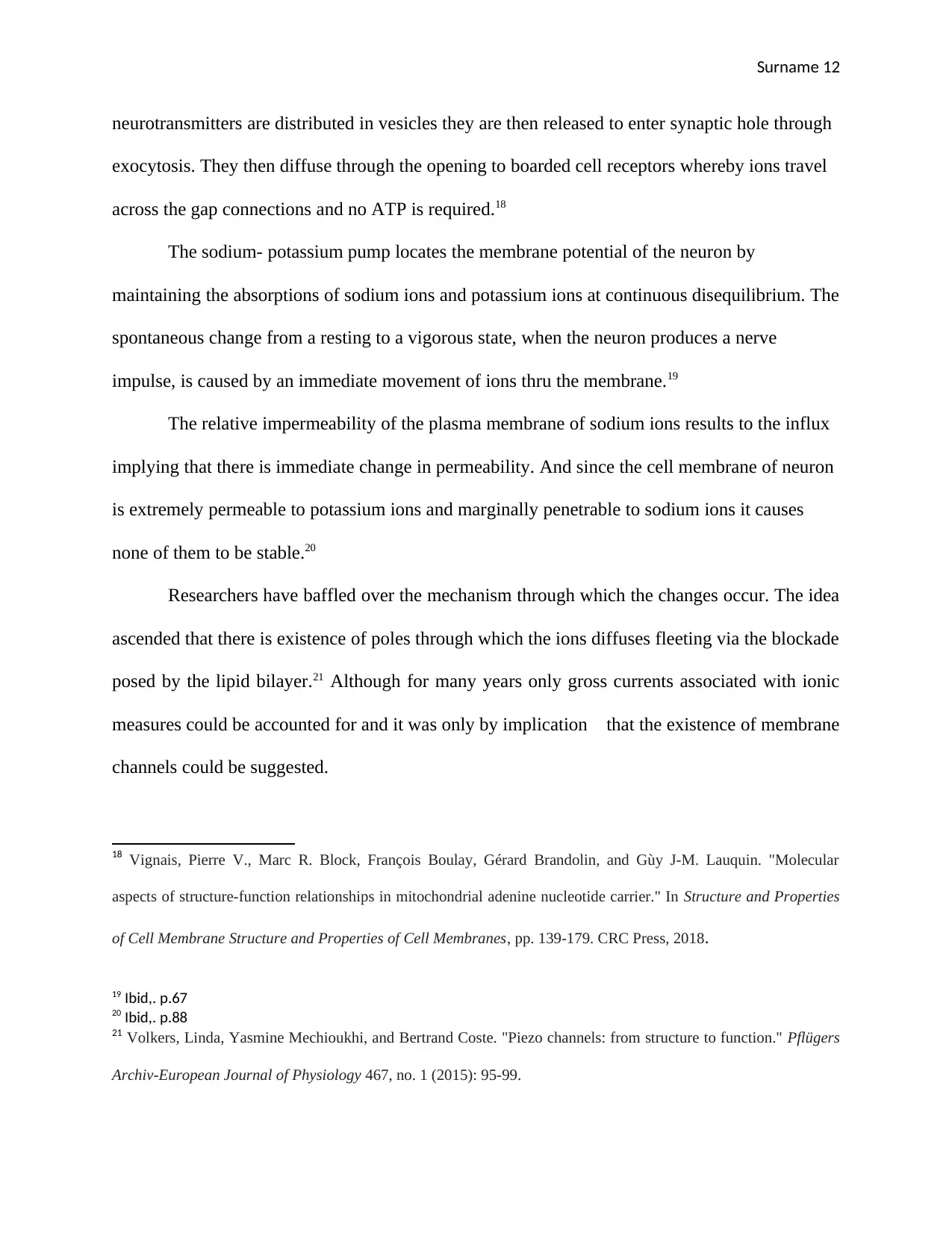
Surname 12
neurotransmitters are distributed in vesicles they are then released to enter synaptic hole through
exocytosis. They then diffuse through the opening to boarded cell receptors whereby ions travel
across the gap connections and no ATP is required.18
The sodium- potassium pump locates the membrane potential of the neuron by
maintaining the absorptions of sodium ions and potassium ions at continuous disequilibrium. The
spontaneous change from a resting to a vigorous state, when the neuron produces a nerve
impulse, is caused by an immediate movement of ions thru the membrane.19
The relative impermeability of the plasma membrane of sodium ions results to the influx
implying that there is immediate change in permeability. And since the cell membrane of neuron
is extremely permeable to potassium ions and marginally penetrable to sodium ions it causes
none of them to be stable.20
Researchers have baffled over the mechanism through which the changes occur. The idea
ascended that there is existence of poles through which the ions diffuses fleeting via the blockade
posed by the lipid bilayer.21 Although for many years only gross currents associated with ionic
measures could be accounted for and it was only by implication that the existence of membrane
channels could be suggested.
18 Vignais, Pierre V., Marc R. Block, François Boulay, Gérard Brandolin, and Gùy J-M. Lauquin. "Molecular
aspects of structure-function relationships in mitochondrial adenine nucleotide carrier." In Structure and Properties
of Cell Membrane Structure and Properties of Cell Membranes, pp. 139-179. CRC Press, 2018.
19 Ibid,. p.67
20 Ibid,. p.88
21 Volkers, Linda, Yasmine Mechioukhi, and Bertrand Coste. "Piezo channels: from structure to function." Pflügers
Archiv-European Journal of Physiology 467, no. 1 (2015): 95-99.
neurotransmitters are distributed in vesicles they are then released to enter synaptic hole through
exocytosis. They then diffuse through the opening to boarded cell receptors whereby ions travel
across the gap connections and no ATP is required.18
The sodium- potassium pump locates the membrane potential of the neuron by
maintaining the absorptions of sodium ions and potassium ions at continuous disequilibrium. The
spontaneous change from a resting to a vigorous state, when the neuron produces a nerve
impulse, is caused by an immediate movement of ions thru the membrane.19
The relative impermeability of the plasma membrane of sodium ions results to the influx
implying that there is immediate change in permeability. And since the cell membrane of neuron
is extremely permeable to potassium ions and marginally penetrable to sodium ions it causes
none of them to be stable.20
Researchers have baffled over the mechanism through which the changes occur. The idea
ascended that there is existence of poles through which the ions diffuses fleeting via the blockade
posed by the lipid bilayer.21 Although for many years only gross currents associated with ionic
measures could be accounted for and it was only by implication that the existence of membrane
channels could be suggested.
18 Vignais, Pierre V., Marc R. Block, François Boulay, Gérard Brandolin, and Gùy J-M. Lauquin. "Molecular
aspects of structure-function relationships in mitochondrial adenine nucleotide carrier." In Structure and Properties
of Cell Membrane Structure and Properties of Cell Membranes, pp. 139-179. CRC Press, 2018.
19 Ibid,. p.67
20 Ibid,. p.88
21 Volkers, Linda, Yasmine Mechioukhi, and Bertrand Coste. "Piezo channels: from structure to function." Pflügers
Archiv-European Journal of Physiology 467, no. 1 (2015): 95-99.
⊘ This is a preview!⊘
Do you want full access?
Subscribe today to unlock all pages.

Trusted by 1+ million students worldwide
1 out of 23
Related Documents
Your All-in-One AI-Powered Toolkit for Academic Success.
+13062052269
info@desklib.com
Available 24*7 on WhatsApp / Email
![[object Object]](/_next/static/media/star-bottom.7253800d.svg)
Unlock your academic potential
Copyright © 2020–2025 A2Z Services. All Rights Reserved. Developed and managed by ZUCOL.





